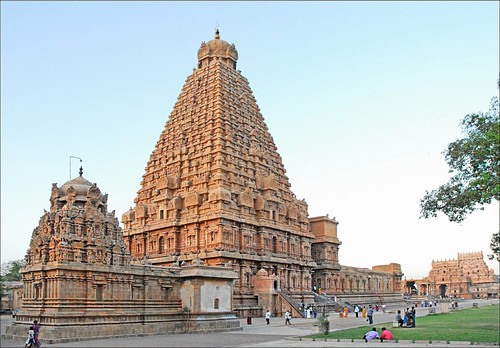Raja Raja Chola I, commonly known as Raja Raja the Great, was an iconic king who left an indelible mark on South Indian history. His reign witnessed unparalleled achievements in governance, military conquests, and remarkable architectural marvels.
Among his many accomplishments, the construction of the Thanjavur Big Temple, also known as Thanjai Periya Kovil, stands as a testament to his vision, power, and patronage of the arts.
Who Built the Thanjavur Temple?
Raja Raja Chola I ascended the throne of the Chola dynasty in 985 CE, marking the beginning of a remarkable era in South Indian history. His reign witnessed the pinnacle of Chola power and territorial expansion, encompassing parts of present-day Tamil Nadu, Andhra Pradesh, Kerala, and even reaching Sri Lanka and the Maldives.
Raja Raja Chola's rule is celebrated for its administrative brilliance, military conquests, and his fervent patronage of the arts.
Under his able leadership, the Chola Empire flourished economically, establishing trade relations with various kingdoms across the Indian Ocean. The empire's naval prowess and thriving maritime trade brought immense wealth and cultural exchanges, further enriching the Chola civilization.
The Thanjavur Big Temple- Architectural Marvel
Among Raja Raja Chola I's most significant achievements, the construction of the Thanjavur Big Temple is a testament to the grandeur and architectural brilliance of the Chola civilization.
Built between 1003 and 1010 CE, the temple complex represents a pinnacle of Dravidian architecture and continues to inspire awe with its intricate craftsmanship and monumental structure.
Dedicated to Lord Shiva, the Thanjavur Big Temple boasts a towering vimana, or tower, that stands at a height of approximately 63 meters, making it one of the tallest in India.
The vimana is adorned with elaborate carvings, narrating mythological stories, showcasing celestial beings, and providing insights into the social and cultural fabric of Chola society.
The intricate details, precision, and symmetry of the carvings reflect the unparalleled artistic skills of the Chola craftsmen.
The main sanctum of the Thanjavur Big Temple houses a colossal lingam, the sacred symbol of Lord Shiva. The inner walls of the temple complex feature inscriptions that provide valuable historical and cultural insights into the Chola era.
The temple also comprises multiple mandapams, or pillared halls, each characterised by unique architectural elements, such as delicate sculptures, intricate friezes, and majestic pillars.
Engineering Brilliance of the temple
The construction of the Thanjavur Big Temple is a testament to the engineering brilliance of the Chola civilization. The temple was built using granite blocks, meticulously carved and interlocked without the use of mortar.
The Cholas employed advanced engineering techniques, including precise measurements, perfect symmetry, and structural stability, which have ensured the longevity and durability of the temple for centuries.
The towering vimana of the Thanjavur Big Temple exemplifies the Chola's expertise in architectural design and engineering. The vimana's intricate construction with multiple tiers, finely sculpted figures, and exquisite detailing reflects the Chola's mastery of geometry, proportion, and balance.
Religious and Cultural Significance of the temple
The Thanjavur Big Temple has been a hub of religious and cultural activities for centuries. It continues to attract devotees, scholars, and art enthusiasts from around the world.
The annual Brihadeeswara Temple Car Festival, also known as the "Raja Raja Chola festival," pays homage to the king and his architectural marvel, drawing devotees and tourists alike.
Preservation and UNESCO World Heritage Site
Recognizing its cultural and historical significance, the Thanjavur Big Temple was inscribed as a UNESCO World Heritage Site in 1987. Efforts have been made to preserve and maintain this architectural gem, ensuring its legacy endures for future generations.
Raja Raja Chola I's reign and his grand creation, the Thanjavur Big Temple, hold an esteemed position in South Indian history. The king's visionary leadership and passion for art left an indelible mark on the cultural heritage of the region.
The Thanjavur Big Temple, with its architectural brilliance and spiritual aura, continues to captivate visitors, serving as a testament to the glorious legacy of Raja Raja Chola and the Chola dynasty.
Written by- Johan Rosario
Edited By- Radhika Agrawal









0 Comments